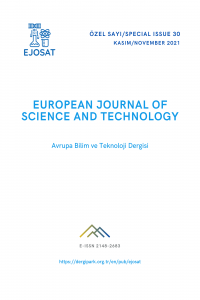Otonom Sistemlerde Veri Çoğaltma Yöntemleri Kullanılarak İyileştirilmiş Gerçek Zamanlı Nesne Tespiti
Abstract
İnsan müdahalesi olmadan çalışan sistemler savunma sanayi başta olmak üzere pek çok alanda gün geçtikte önemi ve kullanımı
artmaktadır. Bu sistemlerde insan faktörü azaltılarak maliyet ve zamandan kazanç sağlansa da görüntü işleyerek çalışan sistemlerde
doğruluk oranının yüksek olmaması durumunda yeni problemler ortaya çıkmaktadır. İnsan müdahalesi olmadan çalışan kara araçları
için levha tespitindeki hatalı tespit problemleri, hava araçlarında ise iniş noktasının doğru tespit edilememesi gibi problemlerdir. Bu
çalışmada hava aracından çekilmiş görüntüler kullanılmıştır. Bu görüntüler üzerinde çeşitli veri çoğaltma yöntemleri kullanılarak nesne
tespit oranının arttırılmasıyla tespit problemlerinin giderilmesi üzerine çalışılmıştır. Veri çoğaltma yöntemlerinde Gaussian, karlanma,
gölgelendirme, yüksek gama, Kontrast Sınırlı Uyarlanabilir Histogram Eşitleme (CLAHE), arttırılmış parlaklık, azaltılmış parlaklık
yöntemleri uygulanarak veri çoğaltma işlemi yapılmış olup nesne tespitinde kullanılacak olan model eğitimi YOLOv4 algoritmasıyla
gerçekleştirilmiştir. Sonuçlar gözlemlendiğinde 8000 tekrar sonrasında başarı oranının %94’e kadar çıktığı ve kayıp (loss) değerinin
0.42 sonucunu verdiği gözlemlenmiştir. Eğitilen model simülasyon ortamına gerek duyulmadan gerçek araçta denenmiştir.
Supporting Institution
Konya Teknik Üniversitesi
Thanks
Yazarlar ayrıca Konya Teknik Üniversitesi RAC-LAB Araştırma Laboratuvarı'na (http://www.rac-lab.com) teşekkür eder.
References
- (2021) Kontrast Sınırlı Uyarlanabilir Histogram Eşitleme (CLAHE), [Online]. Available: https://github.com/YuAo/Accelerated-CLAHE
- FBochkovskiy, Alexey, et al. “YOLOv4: Optimal Speed and Accuracy of Object Detection.” ArXiv:2004.10934 [Cs, Eess], Apr. 2020. arXiv.org
- (2021) Image Filters: Gaussian Blur [Online]. Available: https://aryamansharda.medium.com/image-filters-gaussianblur-eb36db6781b1
- ŞEKER, Abdulkadir, et al. Derin Öğrenme Yöntemleri ve Uygulamaları Hakkında Bir İnceleme. 15 Nov. 2017. dergipark.org.tr,
- Meeus, Wim, et al. "An overview of today’s high-level synthesis tools." Design Automation for Embedded Systems 16.3 (2012): 31-51.
- Yamashita, Rikiya, et al. "Convolutional neural networks: an overview and application in radiology." Insights into imaging 9.4 (2018): 611-629
- Neubeck, Alexander, and Luc Van Gool. "Efficient nonmaximum suppression." 18th International Conference on Pattern Recognition (ICPR'06). Vol. 3. IEEE, 2006.
Abstract
The importance and application of systems that work without human involvement are growing in many industries, particularly in the
defense industry. Although minimizing the human role in these systems saves money and time, it also introduces new challenges if the
accuracy rate in image processing systems isn't high enough. Erroneous traffic sign detection for land vehicles running without human
assistance, as well as a failure to correctly estimate the landing site in aircraft. In this study, images from the plane were collected and
used to enhance object detection in autonomous systems. On these photos, several data augmentation approaches have been used to try
to alleviate the detection challenges by increasing the object detection rate. Data reproduction methods included Gaussian, snow,
shading, high gamma, Contrast Limited Adaptive Histogram Equalization (CLAHE), raised luminance, and lowered luminance
methods, as well as data augmentation. The YOLOv4 algorithm was utilized to train the model for object detection. When the findings
were examined, it was discovered that after 8000 repetitions, the success rate had increased to 94 percent, and the loss value had
decreased to 0.42. In addition to the simulation environment, the trained model was also evaluated in a real ground vehicle.
References
- (2021) Kontrast Sınırlı Uyarlanabilir Histogram Eşitleme (CLAHE), [Online]. Available: https://github.com/YuAo/Accelerated-CLAHE
- FBochkovskiy, Alexey, et al. “YOLOv4: Optimal Speed and Accuracy of Object Detection.” ArXiv:2004.10934 [Cs, Eess], Apr. 2020. arXiv.org
- (2021) Image Filters: Gaussian Blur [Online]. Available: https://aryamansharda.medium.com/image-filters-gaussianblur-eb36db6781b1
- ŞEKER, Abdulkadir, et al. Derin Öğrenme Yöntemleri ve Uygulamaları Hakkında Bir İnceleme. 15 Nov. 2017. dergipark.org.tr,
- Meeus, Wim, et al. "An overview of today’s high-level synthesis tools." Design Automation for Embedded Systems 16.3 (2012): 31-51.
- Yamashita, Rikiya, et al. "Convolutional neural networks: an overview and application in radiology." Insights into imaging 9.4 (2018): 611-629
- Neubeck, Alexander, and Luc Van Gool. "Efficient nonmaximum suppression." 18th International Conference on Pattern Recognition (ICPR'06). Vol. 3. IEEE, 2006.
Details
| Primary Language | Turkish |
|---|---|
| Subjects | Engineering |
| Journal Section | Articles |
| Authors | |
| Publication Date | December 15, 2021 |
| Published in Issue | Year 2021 Issue: 30 |


